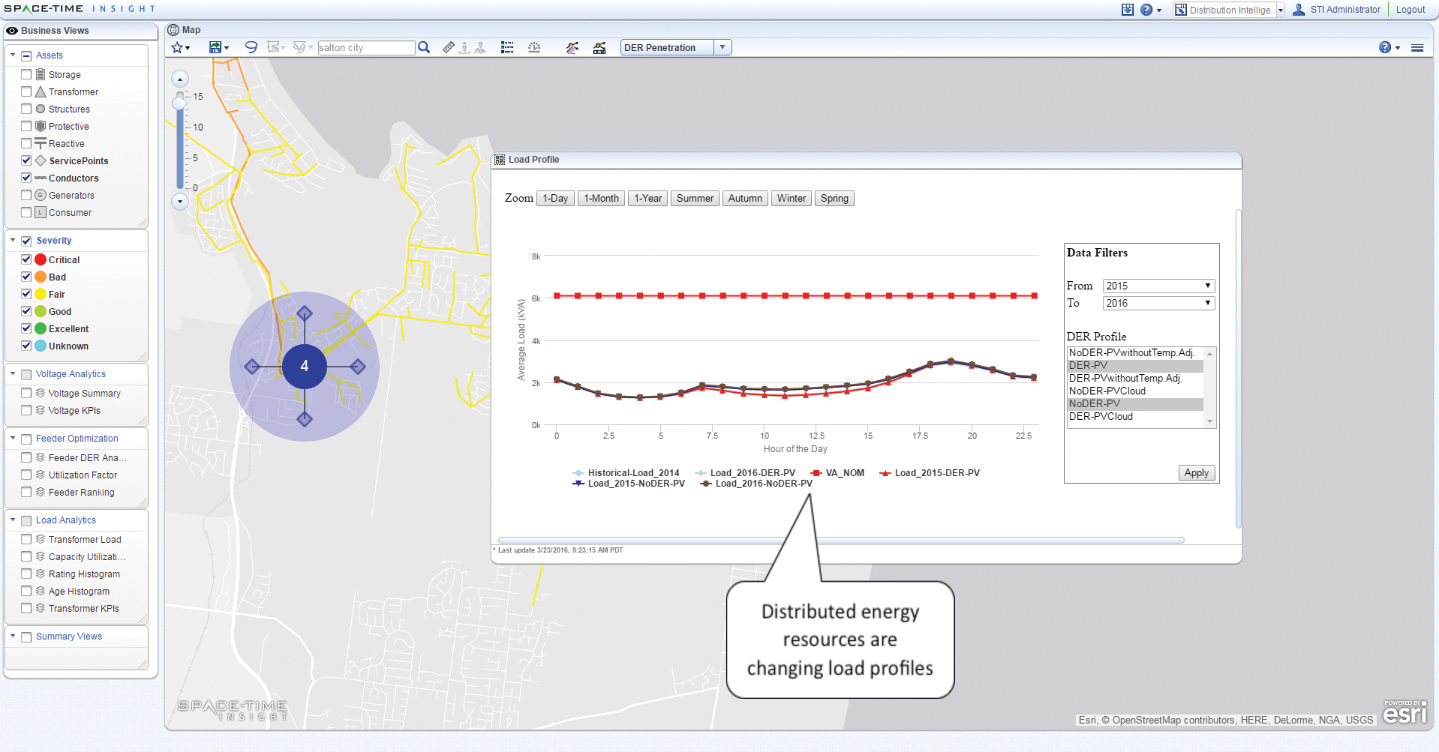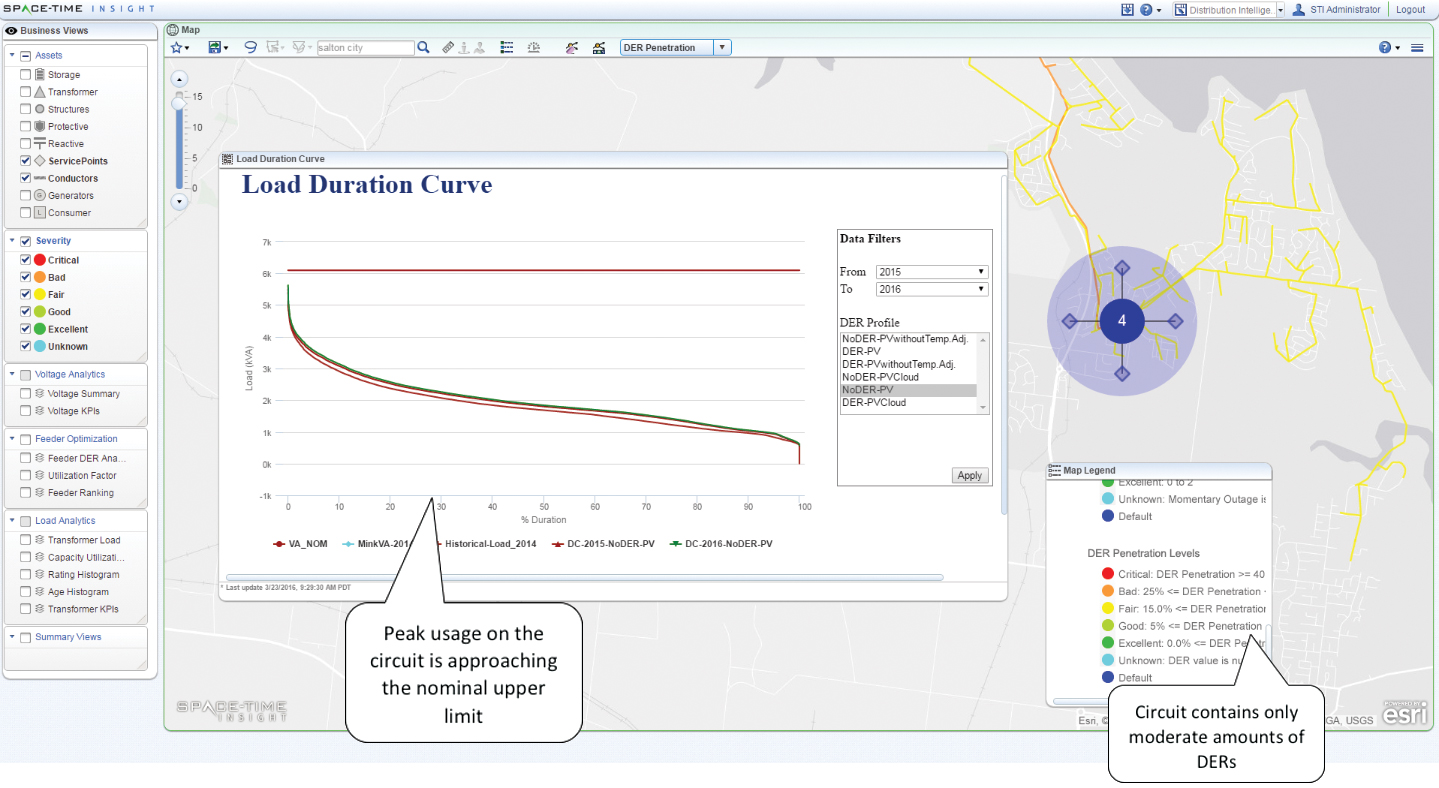How do you move, consciously and deliberately, from the past to the future?
More specifically, how do you make the most of your existing distribution infrastructure while planning for and taking advantage of new technology?
Today’s electricity distribution system is caught between the aging, one-way power flow infrastructure of the past and the rapidly arriving future of decentralized generation and storage coupled with demand response, big data and analytics.
Many utilities like yours are currently experiencing stagnant load growth on an annual basis, but more volatile demand levels on any given day.
In the past, you would have upgraded the neighborhood distribution circuit to handle the higher daily peaks. Today, you have the opportunity to employ emerging technology to make your existing infrastructure last longer and provide a bridge to the future.
Making the Most of What We Have
Load profiles show us the peaks and troughs of projected daily power use. Distributed energy resources (DERs) are driving changes in traditional load profiles. Across the neighborhoods you serve, rooftop solar generates large amounts of power during the day, then drops off precipitously when evening arrives. Electric vehicles take large amounts of energy off the distribution grid at night, previously a period of low consumption. These changes run counter to the historic power usage patterns of daytime peaks and nighttime lows.
You can create a more complete picture of load by predicting the impact on the service point of rooftop solar, energy storage, demand response and energy efficiency. Matching these new distributed energy resources to the volatility in local usage allows you to meet demand without upgrading the local circuit.
This new approach gives you two main benefits:
- One, it can happen much faster than a substation and/or circuit upgrade. That means you can satisfy customers and regulators more quickly.
- Two, it postpones the capital outlay needed for the upgrade. The ability to postpone for 5-7 years the $5-10 million costs to upgrade a substation gives you real, measurable benefit. Aggregate that benefit across multiple substations and circuits, and combine it with other benefits such as better power quality and reliability, higher customer satisfaction and fewer, shorter power outages, and you have a solid bridge to the future.
Relying on new, distributed energy technologies to meet demand isn’t free, but it is less expensive. Your circuits may even eventually need an upgrade. However, the twin results of faster response and delayed investment make integrating DERs into the distribution grid an attractive alternative.
Applying Distribution Intelligence
The problem of what distributed energy resource is needed where and when to balance out a circuit is a perfect use case for situational intelligence applications.
Situational intelligence applications analyze simultaneously the spatial, temporal and network aspects of a problem to provide the what, where, when, why and how for any asset or event. The results of that analysis are then visualized for rapid comprehension and decision making.
For example, this screen shot shows a situational intelligence application for integrating distributed energy resources such as rooftop solar into your distribution network.
You can see that the highlighted portion of the distribution network has been experiencing periods of high peak usage, and yet contains only moderate amounts of distributed energy resources. This portion of the network could be a prime candidate for adding more rooftop solar to help offset the high peak usage.
(Of course, this assumes that the periods of peak usage coincide with period of high solar energy production. Such might be the case on hot, sunny days when residential air conditioners are running. If the peak periods of energy demand and solar production don’t coincide, for example with a neighborhood full of electric vehicle owners, you might need to install local energy storage along with the rooftop solar. That way, excess energy generated by solar systems could be stored and then later released to offset peak demand.)
By factoring in existing and potential distributed energy resources into the distribution network, you decrease the peak load without the need for a capital project to increase the capacity of the circuit.
Summary
The future of energy is here, today, in your service area: rooftop solar power, home-scale batteries, electric cars, high-efficiency appliances, smart thermostats, demand response programs.
However, the future doesn’t come with a clean slate. You must accommodate what came before, including the assets and infrastructure that you already have in place. The future is evolutionary, and evolution requires time. By taking advantage of emerging technology, you can buy more time for your aging infrastructure while the new energy future continues to evolve.
About the Author
 Matthew Spaur is Senior Marketing Manager at Space-Time Insight. He’s an energy and technology veteran with previous roles at Microsoft and Itron.
Matthew Spaur is Senior Marketing Manager at Space-Time Insight. He’s an energy and technology veteran with previous roles at Microsoft and Itron.










